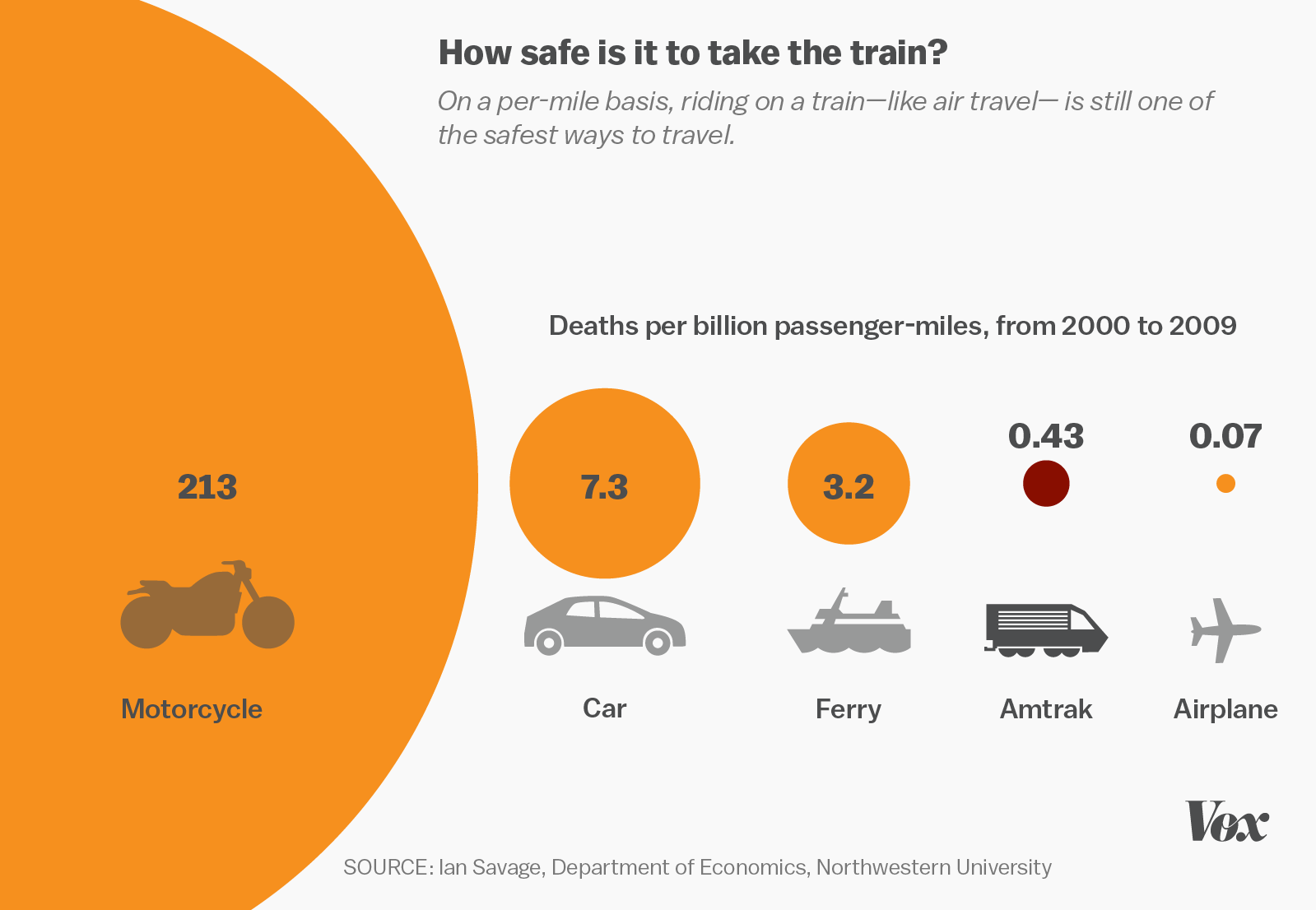It’s an older article, but the point stands!
Before I make this statement, yeah, I know where I am.
Deaths per billion passenger-miles
All of these fatality rates, for all of these forms of transportation, are vanishingly small. Comparing the rates of one vehicle to another with phrases like “17 times more likely” while ignoring the “billion passenger-miles” scale is misleading.
In order to present these in a more complete way, the odds of dying on each of these vehicles is:
- Motorcycle: 0.000000213
- Car: 0.0000000073
- Ferry: 0.0000000032
- Amtrak: 0.00000000043
- Airplane: 0.00000000007
That is per mile, which is usually not the distance humans limit themselves to in their lives. Assuming you travel a million miles in your life, you do have a 20% chance of dying if exclusively using a motorcycle, which I would consider relevant. The change from car to train already far less so.
Fair and excellent points.
Assuming 20,000 miles traveled per year, it would take 50 years to reach 1,000,000 miles. So let’s lay out the % odds of fatality over 50 years, at 20,000 miles per year, if using each of these means exclusively:
- Motorcycle: 21.3%
- Car: 7.3%
- Ferry 3.2%
- Amtrak: 0.43%
- Airplane: 0.07%
You’re also getting at another important point: it is difficult for people to really comprehend very large or very small numbers. With that in mind, if we divide each of those percentages by 50, we should come up with the odds of dying in a given vehicle per year, again, given a 20,000 mile per year usage and exclusive use of one vehicle type:
- Motorcycle: 0.426%
- Car: 0.146%
- Ferry: 0.064%
- Amtrak: 0.0086%
- Airplane: 0.0014%
Of these, only motorcycle and car are anywhere near significant, and they’re still really unlikely. The remaining three still are small enough to be essentially incomprehenisble. (And who travels 20,000 miles a year on a ferry, anyway?)
Another bit I would like to note is that the comparison posed was between car and train, based on safety. Why was airplane not mentioned? It’s far and away the least likely to kill you.
Of course airplane wasn’t mentioned. Airplanes are not appropriate solutions to many kinds of necessary travel, and airplanes in general have a worse reputation for their environmental effects. Trains are not solutions to many kinds of necessary travel, either, at least not in the current landscape of travel options available to very many people in the United States.
Again, I know exactly where I’m commenting. I definitely think that there should be way more public transportation options available. I think the number of individual-operated vehicle miles can and should be reduced. I think the kinds of individual-operated vehicles should be addressed more sensibly (we don’t get to have the small pickups of the 80s and 90s because of unintended consequences of CAFE standards driving manufacturers to create larger and larger “light” trucks, for example).
Pointing out that “cars are 17 times more likely to kill you than trains!” does not serve the purpose of making a better world through transportation reform.
if we divide each of those percentages by 50, we should come up with the odds of dying in a given vehicle per year,
I’m being very nitpicky but this isn’t quite how it works, if you have a 90% chance of survival one year, you’d have 0.9^2 = 0.81= 81% chance of surviving two years in a row. With that in mind, the odds of dying should be relative to the fiftieth root of surviving fifty years, which gives:
- Motorcycle: 0.478%
- Car: 0.151%
- Ferry: 0.065%
- Amtrak: 0.0086%
- Airplane: 0.0014%
Without additional decimals it’s hard to see the change for the really small numbers but it doesn’t make much of a difference in reality.
Thank you, 1/5 of lifetime motorcyclists dying in wreck doesn’t add up.
I have no idea about the statistics about motorcycle fatalities and for personal reasons I’d prefer not to get into them. I was just commenting on the way the statistics were calculated year-by-year with the assumption that the original statistics for fifty years were accurate. That being said, it’s possible that those statistics were not completely correctly calculated as well.
The fifty year statistics were also computed wrong, for the same reason you already explained. It doesn’t make much of a difference since the probabilities are so small anyway.
Trains are not solutions to many kinds of necessary travel, either, at least not in the current landscape of travel options available to very many people in the United States.
That’s kind of the point though. Trying to get folks in the US to support better travel infrastructure. Doesn’t even always have to be trains.
Pointing out that “cars are 17 times more likely to kill you than trains!” does not serve the purpose of making a better world through transportation reform.
Why not? Everything you said honestly made it sound like everything else is a much safer alternative than personal vehicles. Why is that not an argument for better infrastructure and transportation reform? I’ve known people who have died in car accidents. I do not know anyone that’s even been in a train accident let alone killed in one. Your numbers are not that supportive of cars being generally safe. Those are not great odds when considering the loss is catastrophic. It’s probably one of the biggest risks folks willingly take and will actively avoid lesser risks.
Also not saying it’s wrong, but why are we dividing by 50? It’s per mile basis. If it’s 20000 miles per year, it’s already by year, no?
Your math is not correct on this. You have stated the rate of deaths per mile, not the probability of not dying per mile, e.g. if 2 people died per mile, then the probability of dying per mile is not 200%.
I believe this should follow a Poisson distribution, i.e.f(k;m) = ((rm)^k * e^-(rm)) / k!, where k is the number of deaths, m is the miles traveled, and r is the deaths per mile. Then, the probability of dying after traveling m miles is 1 - f(0;m), i.e. the probability of no deaths occurring. Thus, the probability of dying when traveling 10^6 miles is 1 - e^-(7.3 / 10^9 * 10^6) = 0.727%.
Bike not listed.
I’m invincible!
Depends on where you ride your bicycle.
In the US, bicycle deaths are at 79 per billion miles src. In the Netherlands, this is 17 per billion miles. src.
Note that the Dutch take much more risk when cycling. It is normal for young kids to cycle to school and sports unsupervised. Bicycle helmets are very rare. Despite that “reckless behavior”, cycling is quite safe here. Having dedicated cycling infrastructure really helps.
i want to build a fuck_planes community, but i doubt anyone will get…on board. cars are less of an issue (just demand smaller cars, high wheelers need to be abolished, luckely they aren’t common in europe). planes are the bigger threat for now. we need to get our priorities straight.
For short haul flights where a train is preferable, or private iets, absolutely. However airplanes are still the most efficient way to travel long distances. Abolishing airplanes altogether is one of the least thought out takes I’ve ever heard.
Abolishing airplanes altogether is one of the least thought out takes I’ve ever heard.
yea, not altogether. i commented on this before https://lemm.ee/comment/2119584 : air travel should be limited only to transcontinental travel or cross country in Asia’s case (since its a bunch of isles at that point) efficient? ofc, moneywise and timewise. environemently friendly? dont think so. thoses tons of burned kerosene would translate into tons of co2 released, in a single flight. no wonder our globe feels like a microwaved cookware. fast and affordable have a cost.
i drew the analogy from the game warcraft: u only need to pay for a zeppelin when u want to reach somewhere that couldn’t be accessed by land, in a map. we just live in a bigger map.
I’ve driven probably 750k miles in a big truck and I’ve been in zero accidents and died 0 times. Statistics only tell you part of the truth. You can probably decrease your own risk by a whole bunch by being an attentive driver, not texting and driving, and never driving high or drunk.
And people are afraid of airplanes




